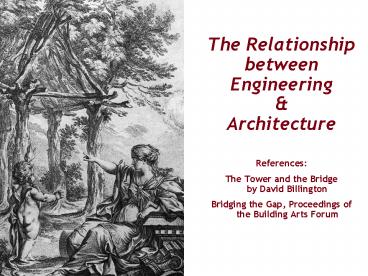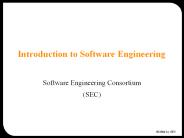The Relationship between Engineering - PowerPoint PPT Presentation
1 / 45
Title:
The Relationship between Engineering
Description:
between Engineering & Architecture References: The Tower and the Bridge by David Billington Bridging the Gap, Proceedings of the Building Arts Forum – PowerPoint PPT presentation
Number of Views:129
Avg rating:3.0/5.0
Title: The Relationship between Engineering
1
The Relationship between EngineeringArchitect
ure
- References
- The Tower and the Bridge by David Billington
- Bridging the Gap, Proceedings of the Building
Arts Forum
2
Designers of Three Dimensional Public Spaces
Architects
StructuralEngineers
Sculptors
3
3 Measures of Design Performance
- Efficiency
- Scientific Dimension
- Use of Minimal Natural Resouces
- Economy
- Social Dimension
- Use of Minimal Public Resources
- Must Consider Material Costs Constructability
- Elegance
- Symbolic Dimension
- Aesthetic Motivation of the Designer
4
Efficiency
- Form Controls the Forces
- Form Changes the Actions Reactions
5
Economy
- Dependant upon Time Place
- Quantities are measurable butlabor bidding
process are not
6
Nervi
- A builder and designer of new forms
- ..searching for solutions that were
intrinsically and constructionally the most
economic..
7
Constructability
- Roebling
- numerous dwgs studies of construction methods
8
Constructability
- Eiffel
- 5000 dwgs of parts assembly techniques
- close relationship w/ contractor
- refinement of design
- Pia Maria bridge -gt Garabit Viaduct
- Span 165m, Material wrought iron
9
Constructability
- Morandi
- detailed investigations of construction process
- Span 100m, Rise 20m, Ravine Depth 110m
10
Candela
- Hyperbolic paraboloid concrete shells
- ..the only way to be an artist in this
difficult specialty of building is to be your own
contractor.
11
Elegance
- Aesthetic ideas can be traced back to Viollet le
Duc, Entretiens, (1863, 1872) - Theories on the importance of structural
expression and construction techniques
12
Engineering v. Science
- Engineering (Technology) is
- the making of things that did not previously
exist - creation of specific objects
- Science is
- the discovery of things that have long existed
- creation of general theories that unify knowledge
- To what extent does technological innovation flow
from scientific discovery?
13
Methodology
- Scientific Analysis
- Visual Analysis
- Empirical Analysis
14
Synthesis of Methodologies
- ETH, Zurich,
- Three Principles of Professor Ritter
- importance of calculations, attempts to simplify
analytical procedures - engineers have major responsibilities during
construction - importance of full scale load tests
15
Robert Maillart
- evolution of three-hinged concrete arch bridges
- visual empirical methods
Zuoz Bridge, 38.3m
Stauffacher Bridge, 39.6m
Tavanasa Bridge, 51m
16
The Relationship between Engineering
Architecture
- Schism
- Collaboration
- Synthesis
17
Schism
- separation between architect, engineer and
constructor - pre-schism architect was the Master Builder ie
Brunelleschi
18
What Lead to the Schism
- Industrial Revolution introduced new materials,
methods and aspirations - specialized schools were established
- Ecole des Beaux Arts
- ETH, Zurich
- architectural curricula focused on
- visual methods
- product
- engineering curricula focused on
- numeric methods
- process
19
Role of the Architect Today
- Venturi The Decorated Shed
20
Role of the Architect Today
- Jorn Utzon, Sydney Opera House
21
Role of the Architect Today
- Owens Corning HQToledo, OH
- CMU CBPD team
- exterior architect
- interior architect
- production drawing architect
- curtainwall architect
- engineering disciplines
- construction manager
22
Role of the Engineer Today
- technician vs innovator
- synthesis of scientific empirical knowledge
- debate is raging over appropriate curriculum
23
De Menil Gallery Piano Rice
24
Two Primary Definitions Of Design
The many ways of describing design, which in turn
need to make the assumption that what counts as a
legitimate display of design knowledge has been
agreed upon, has been partially rationalised by
Kees Dorst. Dorst cast the debate as a
dialectic between Simons rational
problem-solving paradigm and Schöns reflective
practice approach. Willemien Visser Design
one, but in different forms (2008)
slide from D.Willis, PSU
25
Two Primary Definitions Of Design Rational
Problem-solving
. . . The boundary between well-structured and
ill-structured problem solving is indeed a vague
and fluid boundary. . . there may be nothing
other than the size of the knowledge base to
distinguish ill-structured problems from
well-structured problems, and that general
problem-solving mechanisms . . . should be
extendable to ill-structured domains without any
need for introducing qualitatively new
components. Herbert A. Simon The Structure of
Ill-structured Problems Artificial Intelligence
4 (1973)
slide from D.Willis, PSU
26
Two Primary Definitions Of Design Reflective
Practice
Conversely, Schön embraces the inherent
complexity of design and regards purely rational
approaches with their reductionist tendencies and
emphasis on quantitative data as unable to cope
with the realities of design in practice. The
reflective practitioner must apply knowledge
and experience to each unique circumstance. Wille
mien Visser Design one, but in different forms
(2008)
slide from D.Willis, PSU
27
Schön Questions The Utility Of Any Particular
Fixed Design Method
Because the unique case falls outside of the
categories of existing theory and technique, the
practitioner cannot treat it as an instrumental
problem to be solved by applying one set of rules
in her store of professional knowledge. Donald
Schön Educating the Reflective Practitioner
(1987)
slide from D.Willis, PSU
28
A Continuum Based On Dominant Design Paradigm
__________________________________________________
Rational problem-solvers
Reflective
practitioners Simonists
Schönians
Note the choice of which paradigm to favor is
not necessarily an informed one for most design
professionals, it is determined by education,
culture and experience, rather than a systematic
examination of the available data and theories.
slide from D.Willis, PSU
29
A Continuum Based On Dominant Design Paradigm
__________________________________________________
______ Rational problem-solvers
Reflective
practitioners Simonists
Schönians
Strong emphasis on methodology
Weak emphasis on methodology Mass-production
orientation Oriented
to one-off artifacts Context idealized or ignored
Context of paramount
importance Efficiency stressed
Efficiency a secondary concern
slide from D.Willis, PSU
30
Two Different Viewpoints
- How does the understanding of space/ structure
from two different viewpoints affect the project
31
Kimball Art Museum Kahn Kommendant
- Is it a Barrel Vaultor is it an Inverted T?
32
Collaboration
- a close working relationship between individuals
from different backrounds - mutual respect
- common vocabulary
33
CCTV Koolhaus Arup
34
Japan Pavilion Expo 2000 Buro Happold Ban
Otto
35
BMW Welt Coop Himmelb(l)au BG
36
Mercedes Museum UN Studio Werner Sobek
37
Soumaya Museum LAR Fineout Gehry
Technologies
38
Soumaya Museum LAR Fineout Gehry
Technologies
39
Soumaya Museum LAR Fineout Gehry
Technologies
40
Soumaya Museum LAR Fineout Gehry
Technologies
41
Synthesis
- Can there be a modern day master builder?
- Nervi, Candela, Wright, Rogers, Calatrava
42
Can the synthetic process be one of skillful
coordination?
- Specialists and manufacturers are taking a bigger
role in the process - Maki, Fujisawa, Gymnasium Roof
- Ando, Mt Rokko Chapel, Ground Glass
- Foster, Hong Kong Shanghai Bank
43
Synthesis
- Can we transfer technologies and solutions from
other disciplines? - NASA, composites, ceramics, polymers
44
Synthesis
- Can the synthetic process be a redefinition of
the problem? - Traditional process
- client, architect, builder
- design - bid - build
- Owens Corning Process
- CM hires specialized disciplines
45
Conclusion
- No definitive answers
- CMU curriculum helps to expose you to these
issues so that you are better prepared for the
future but, - while you have architects engineers for
teachers you do not collaborate with engineering
students in the studio - Push yourselves to understand the relationship
between engineering architecture through the
vehicle of this studio































